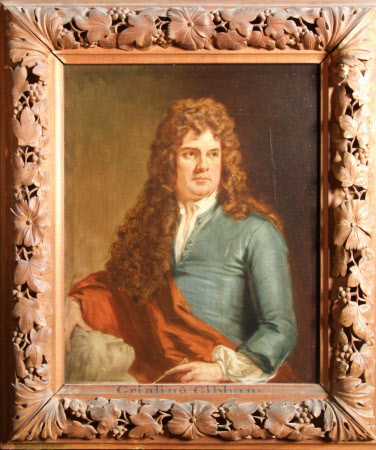Grinling Gibbons (1648-1721)
George Clint, ARA (London 1770 - Kensington 1854)
Category
Art / Oil paintings
Date
circa 1800
Materials
Oil on canvas
Measurements
370 x 290 mm
Order this imageCollection
Petworth House and Park, West Sussex
NT 486807
Caption
Grinling Gibbons was a woodcarver and sculptor. He was born in Rotterdam, but had settled in England by 1671. The discovery at Petworth of a payment to Gibbons in 1692, which almost certainly refers to work in the Carved Room, seems to confirm the well-founded story that Gibbons had been employed at Petworth by Charles Seymour, 6th Duke of Somerset (1662-1748). Apart from the highly skilled nature of the carving, the evidence for Gibbons having worked at Petworth rests on a letter written by Horace Walpole to George Montagu on 26 August 1749. In it he describes the carving in the so-called Grinling Gibbons room as ‘much the finest carving of Gibbons’ that ever my eyes beheld’. In this work Gibbons co-operated with Selden, to whom payments were made in 1689 and 1692. The carved frame on this painting is by Jonathan Ritson (c.1780-1846).
Summary
Oil painting on canvas, Grinling Gibbons (1648-1721) by George Clint, ARA (London 1770 – Kensington 1854), circa 1800. A half-length portrait, full face, eyes to the right, wearing blue and brown-rose and with a carved head (the head of Proserpina from Bernini's Pluto and Proserpina in thge Villa Borghese, Rome) in his right hand. In reverse (after an engraving of around 1690/1700 by John Smith) from Kneller's original portrait of the 1680s, an example of which was formerly at Houghton (collection of Sir Robert Walpole) and having been sold to Catherine the Great in 1799, is now in the Hermitage, St Petersburg (GE1346). The recent discovery at Petworth of a payment to Gibbons in 1692, which almost certainly refers to work in the Carved Room, seems to confirm the well-founded story that Gibbons had been employed at Petworth by Charles Seymour, 6th Duke of Somerset (1662-1748). Apart from the highly skilled nature of the carving, the evidence for Gibbons having worked at Petworth rests on a letter written by Horace Walpole to George Montagu on 26 August 1749. In it he describes the carving in the so-called Grinling Gibbons room as "much the finest carving of Gibbons' that ever my eyes beheld". In this work Gibbons cooperated with Selden, to whom payments were made in 1689 and 1692. At the same time the Duke of Somerset, who was Chancellor of the University, was employing Gibbons in the Library of Trinity at Cambridge. Gibbons statue of the Duke was done for the College in 1681.
Provenance
Commissioned by the 3rd Earl of Egremont for the Carved Room, thence by descent, until the death in 1952 of the 3rd Lord Leconfield, who had given Petworth to the National Trust in 1947, and whose nephew and heir, John Wyndham, 6th Lord Leconfield and 1st Lord Egremont (1920-72) arranged for the acceptance of the major portion of the collections at Petworth in lieu of death duties (the first ever such arrangement) in 1956 by H.M.Treasury.
Credit line
Petworth House, The Egremont Collection (acquired in lieu of tax by HM Treasury in 1956 and subsequently transferred to the National Trust)
Makers and roles
George Clint, ARA (London 1770 - Kensington 1854), artist
